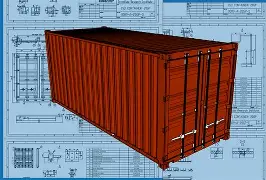How to Inspect a Shipping Container Before Purchase a buyers guide.
Purchasing a shipping container is a significant investment, whether for storage, modification, or transportation purposes. To ensure you get the best value, it’s crucial to inspect the container thoroughly before making a purchase. Our team at Century Containers undergo a rigorous checklist of all containers that we welcome into our depots to ensure the best quality for our customers. This often starts at point of purchase, with all New 1-Trip containers been purchased at port of origin or after their first leg. Used containers come with even stricter rules to determine if they are worthy of not only use, but that the shipping container meets and exceeds all necessary standards to ensure it has longevity of use for our customers.
Here’s a comprehensive checklist of key factors to consider when inspecting a shipping container.
Exterior Inspection
- Overall Condition
- Check for any visible damage, dents, or warping. The container should have a uniform shape without any bulging or significant deformations. Warping is especially considered no matter how minor. This is because when the container is settled in place, any twisting of the unit can cause doors to become jammed and hard to open. So we ensure all our shipping containers are perfectly square before we take them to customers.
- Rust and Corrosion
- Inspect the container for rust, especially around the corners, edges, and seams. Surface rust is common, but extensive rust or corrosion can compromise the container’s integrity. We work with some of the Europe's biggest container aggregate companies to maintain and repair their shipping containers. This means we are very used to dealing with extensive rust and corrosion, so we know what we are looking out for!
- Paint and Coating
- Look at the paint job. A fresh coat of paint can hide underlying issues. Ensure the container has proper anti-corrosion coatings and look for signs of peeling or flaking. We offer painting services to all of our customers, our Prepare and paint services removes any and all original flaking paint, rust stains and stickers to ensure hey final coat is smooth and looks good!
- Roof Condition
- Climb up and inspect the roof for dents, rust, and water pooling spots. A well-maintained roof is crucial to prevent water leaks. Dents and divots in roofs can lead to pooling, leading to corrosion and potential leaks. Our team go through each container to remove these whenever possible to prevent this from happening.
Interior Inspection
- Structural Integrity
- Inside, check the walls and floor for any signs of damage or warping. Pay attention to areas that might have been repaired or patched.
- Flooring
- Inspect the wooden flooring for rot, soft spots, or damage. The floor should be even and sturdy. We tend to go over our floors on used containers with either a sander or polisher to fully clean them out. Making sure their are no flakes or sticking up points that may catch.
- Doors
- Open and close the doors to ensure they move smoothly and seal properly. Inspect the rubber seals for wear and tear, as damaged seals can lead to water ingress. We have the tools to replace container seals and any other container door parts. Customers should always check their units door fittings as this can be the most problematic area of a shipping container.
- Odor
- Smell the interior for any strong or unusual odors, which can indicate previous use for transporting chemicals or other hazardous materials.
Functional Checks
- Locking Mechanisms
- Ensure that all locking mechanisms are functional and secure. Locks should be robust and show no signs of tampering. Check your container comes with a lock box to give extra security, if not we can fit one for you!
- Ventilation
- Check for adequate ventilation. Properly ventilated containers help prevent condensation and mold growth.
Certification and Documentation
- CSC Plate
- Verify the presence of a valid CSC (Container Safety Convention) plate, which indicates that the container meets international safety standards. This will also indicate manufacturing date, with the rule of thumb being newer is better! Though this can have its traps, never take a container primarily based upon age, it may have done the harder trips then another container!
- History and Usage
- Ask for the container’s history and what it was previously used for. Avoid containers that were used to transport hazardous materials.
- Inspection Report
- Request a recent inspection report or have the container inspected by a professional to ensure it meets your requirements. This can be provided to our customers through our internal quality assurance systems, creating transparency through the buying process.
Conclusion
By following this checklist, you can ensure that the shipping container you purchase is in good condition and suitable for your needs. A thorough inspection helps avoid costly repairs and ensures the safety and security of your stored items. If you ever need any help, we are here to create simplicity within this process and transparency throughout. Customer satisfaction is number one and we are here to provide any and all shipping container solutions!





